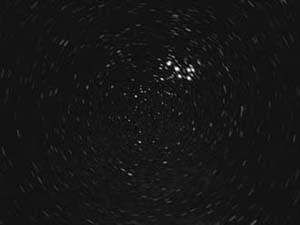3.17. Time-Lapse Photography Time-lapse photography is an effective way to depict a subject changing from one state of being to another: a butterfly emerging from a cocoon, the unfurling of a rose bud, and so on. Obviously, the result you want is a movie, not a still picture ”but that's just fine with you. You've got a Mac, and the Mac has QuickTime. The idea is that you'll take a picture at regular intervals ”once an hour , for example. At the end of eighteen hours, you'll have eighteen images that you can upload to iPhoto for processing. (You'll also be very tired , but that's another story.) You'll then be able to use iPhoto's Export to QuickTime command, which turns your still frames into a live-action movie at the frame rate you specify. Chapter 11 details this process. When setting up for a time-lapse shoot, keep these things in mind: -
Use a tripod. You want every shot to have precisely the same angle, distance, and composition. -
You don't want a lot of changing background activity in your sequence of shots, since it will distract from the main subject. -
Keep the camera plugged into a wall jack (an AC adapter is an extra purchase with most camera models). Changing the batteries once the time-lapse process has begun is sure to alter the camera's original positioning. -
Focus manually (if your camera allows it) to ensure sharpness in every frame. -
Avoid the flash. Close-range flash shooting generally blows your subject into blinding white. -
Experiment with exposure intervals. Try one shot every fifteen minutes for one project, and then repeat the project again using 30-minute intervals. With a little trial and error, you'll find the perfect setting for your subject. Once you've captured your sequence of shots, upload them to iPhoto. Chapter 11 has the full details about creating QuickTime movies of your slide shows. For time-lapse movies, the process is just as described there, with a few additional suggestions. They include: -
Don't crop individual photos. You want them to line up with each other in the finished movie. -
Put all of the pictures into a new album. -
In iPhoto's Export to QuickTime dialog box, choose a duration for each frame along the lines of .25, .50, or 1.0 seconds. POWER USERS' CLINIC
Star Trails | | If you really want to impress your friends with your budding photographic skills, try capturing star trails. Surely you've seen these dramatic shots: one star, located in the center of the frame, remains a point of light, but all the other stars in the universe seem to carve concentric circle segments around it, as though the galaxy were spinning dizzily. That one fixed star, in case you were wondering, is the North Star. It remains steady as all the other stars seem to travel in a circular path around it, thanks to the rotation of the earth. Find some place dark with a clean horizon line. If you want the ground in the shot at all, compose the frame so that the sky fills 90 percent of it, and the ground occupies only the bottom 10 percent. The setup for this shot is the same as for the taillight trails, except that you have to keep the shutter open much longer ”at least fifteen seconds for very short trails as in the example here, or (if your camera can handle it) up to fifteen minutes for dramatic star trails. The photo here, showing the Pleiades constellation (sometimes called the Seven Sisters), was captured with a shutter speed of just a few seconds. The stars are already beginning to "trail." The longer the exposure, the longer the star trails, so push your camera to the limit. If the trails aren't bright enough, then increase your camera's light sensitivity by changing the film speed setting (page 22) to 200 or 400.  |
|
